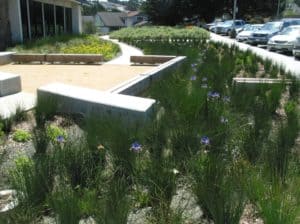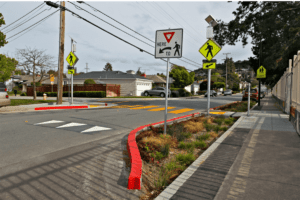In the next few weeks, our region is due for its first major storm of the season. Bay Area residents will be faced with flooding in our neighborhoods and along our commutes. Many of us will see a lot of trash being quite literally flushed from our city streets into local creeks and the Bay, along with a long list of dangerous chemicals and toxic pollutants. Some of that rain could have been captured and stored for local use during the dry season, but it will flow away instead.
One of the reasons that flooding is prevalent in urban areas is because we have paved over most of our land. In natural areas, stormwater is absorbed into the dirt and either percolates into underground aquifers or slowly flows to the nearest creek. Our cities have so little remaining unpaved spaces that stormwater can only pool on the asphalt or flow into the storm drain system, carrying pollution to our creeks and the Bay. Most of our cities’ storm drain systems were built over 50 years ago. Severe underinvestment in these systems have left them inadequate, full of holes, and crumbling. They are becoming a liability.
If we want to protect our cities from flooding, reduce Bay pollution, and improve our resilience to climate change, we need to change the way we manage stormwater. The answer is relatively simple: more green, less grey. More dirt and plants, less asphalt and pipes. What I’m referring to is a broad set of strategies known as green stormwater infrastructure. Green infrastructure is a nature-based approach to managing stormwater flows. By mimicking nature in our built environment and allowing stormwater to filter back into the ground, we not only reduce flooding and pollution, but also gain additional benefits of more green space in urban areas: cooler neighborhoods, a better environment for walking and biking, even improved public health. In some parts of the Bay Area, green infrastructure can send fresh water back down into our groundwater supply, storing it for future use. The many benefits of green infrastructure are especially critical as our communities grapple with climate change, and work to reduce our regional contribution to the problem.

There are examples of green infrastructure in our region demonstrating what should be done everywhere: the Lakeside Green Streets project along Lake Merritt in Oakland; El Cerrito’s rain gardens along San Pablo Avenue; the Chynoweth Avenue Green Streets project in San Jose; and many others.
So why aren’t we doing this everywhere? One major reason is funding. Our cities need help paying for these beautiful and functional spaces. State and federal agencies must make more funding available for green infrastructure, especially for projects along city streets and other public spaces. Our cities need to raise more money for these projects, and that’s usually done through stormwater fees. The City of Alameda is proposing a stormwater fee increase, and we’re advocating for stormwater improvements to be included in a potential parks measure in Oakland.

Finally, we need political leadership to build more green infrastructure in our cities. Some of our elected representatives at the local and state level already share in the vision of greener, climate-resilient communities. San Jose Mayor Sam Liccardo, along with the city council, recently directed city staff to develop a green infrastructure plan with the goal of achieving multiple community and environmental benefits. But in order to avoid more flooding and pollution, green infrastructure planning must happen collaboratively in our cities in every corner of the region, and leadership is needed to drive these multi-stakeholder efforts.
Our vision for Bay Smart Communities that broadly implement green infrastructure is possible to achieve, but only with public support and political leadership. Stay tuned for opportunities advocate for green infrastructure in your community.

















































